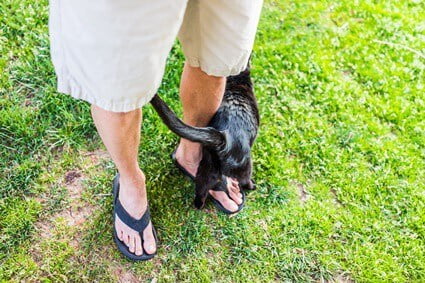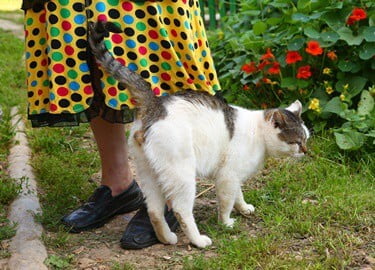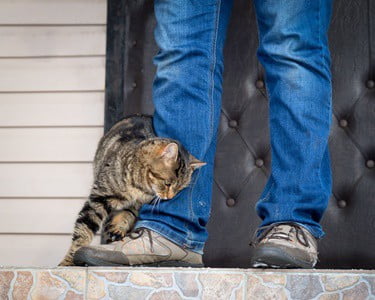Cats are considered mysterious and hard to fathom due to a range of unique and unusual behaviors. However, experienced owners understand feline body language and vocal cues, especially regarding a cat expressing hunger.
A cat knows that rubbing its head or body against your legs will rarely be ignored by an owner. Once a cat has your attention, it will let you know that it wants to be fed. Cats also rub against humans after eating food as an act of gratitude or an expression of affection. A cat could also be marking you as its own property.
Cats aren’t shy about requesting food, usually with verbalization. Even if a cat is quiet, it will meow for food. As per the Journal of Veterinary Science, cats have at least 21 forms of meow. These verbal cues are used to manipulate owners.
How Do Cats Let You Know They are Hungry?
A hungry cat will usually emit an increasingly high-pitched, urgent meow. This will steadily increase in volume the longer the call goes unheeded. In addition, Current Biology explains that some cats use purring to appeal for food.
If verbal cues go ignored in a hungry cat, physical interaction will follow. An ill-tempered or poorly trained cat may grow aggressive, clawing at an owner. More common is the act of rubbing against you to request food.
Why Do Cats Rub Against You When Hungry?
A cat rubbing itself against a human is the oldest trick in the feline book when it comes to gaining attention. Just as owners learn the quirks and foibles of cats, our cats learn how to control humans. The cat will understand that rubbing usually results in petting, food, or something else that’s good.
When your cat rubs against you, check the time. You may have missed a scheduled mealtime. Cats love routine and will notice if you are running late with food. Cats may not wear wristwatches, but they tell time based on their body clock.
The cat may be rubbing against you as it wants to play or to be petted or groomed. Watch how the cat behaves once you acknowledge it. If the cat starts to meow or approaches its food bowl, it is clearly asking to be fed.
Do not be alarmed if this is earlier than usual, especially in the winter. Cats are invariably hungrier during colder seasons. In addition, the sun sets earlier in fall and winter. This means the cat will expect to be fed sooner. It associates darkness with an evening meal.

Why Do Cats Rub Against You After Eating?
Do not be concerned if your cat rubs against your legs after it has finished eating. It does not necessarily mean the cat is still hungry. Immediately rushing to offer more food can lead to obesity.
There are a handful of reasons why cats rub against their owners after being fed. Let’s assess the three most common explanations for this behavior.
Marking
Marking is among the most common explanations for cats to rub against a human. When a cat rubs its fur against your clothing, it is leaving an unmistakable scent. You may not be able to detect this aroma, but other animals certainly can.
This marking behavior ensures that you are confirmed as a source of food. This is important to cats for two reasons. This first is a simple reminder. The cat is making sure it remembers that you have the dexterity to manage a tin opener and will offer food.
The marking also warns off other cats. By marking you, the cat is saying, “this human may have food, but they are taken. Go find somebody else to feed you.” Cats guard anything important to them jealously, including owners.
Gratitude
Your cat may also simply be saying thank you for the meal. Rubbing is a common sign of affection in felines. As cats do not like to be held or restrained, think of this as a hug from your cat.
Cats are rarely fulsome with their feelings, so this gesture should be appreciated. Acknowledge your cat’s gratitude with light petting, but do not pick it up. This mutual exchange of respect and affection will strengthen your bond.
Requesting Seconds
It remains possible that your cat is asking for a second serving of food or a treat. Before you outright refuse this request, writing it off as simple gluttony, consider why this may be.
If you offered a treat after dinner before – even just once – you have your answer. You have established a routine in the mind of the cat. It will expect you to continue to honor this unwritten agreement.
As mentioned, cats also grow hungrier in the winter. Your cat may need its food intake increased by some 15% throughout the day. The best way to achieve this is free-feeding kibble rather than offering a second helping of wet food.
The food that you served your cat may not have been sufficiently filling, either. As obligate carnivores, cats need food that is high in superior protein sources. As per Nutrition Research, food packed with filler carbohydrates will fail to satisfy.
Always feed your cat the highest-quality food that your budget allows, and your cat will accept. In addition, ensure you are feeding an age-appropriate meal. Older cats need to be offered a senior-centric brand of cat food.
What Does it Mean if a Cat Rubs Against You but Does Not Eat?
Your cat has rubbed itself against you, so you laid down a bowl of food – only for the cat to ignore the meal you have prepared. This will understandably provoke anxiety. Cats rarely decline to eat.
Confirm that the cat was indeed asking for food. If the cat approaches toys, it wants to play. If you sit down and the cat leaps into your lap, it wanted petting. Rubbing behavior is not always associated with hunger.
The cat may also be looking for reassurance that it is OK to eat. If your cat is submissive by nature, it may not be comfortable with eating without permission. Make a fuss of the cat, making it obvious that it should start to enjoy its meal.
If your cat sniffs at the food, then walks away, or takes a single bite, then refuses to proceed further, something is amiss. You will need to understand what is causing this inappetence.
You can often assign this without veterinary help, though if none of the explanations below bear fruit, seek professional advice. Cats that refuse to eat for longer than 24 hours are placing themselves at risk.
Change in Food
Cats hate any change, especially to their food. Cats can be fussy about their nourishment and fiercely stubborn. If your usual brand of food was out of stock and you bought an alternative, your cat will notice. It may go on hunger strike to protest.
If you must feed your cat a different food than usual, make it as appealing as possible. For cats, the scent of food is critical. Pour a meaty gravy over the food or tuna juice if your cat prefers fish. This will often tempt the cat into eating.
If you have changed your cat’s food wholesale – from wet food to kibble, for example – it will often refuse to eat. These drastic changes need to be managed steadily. Mix the foods, steadily decreasing the quantity of the familiar favorite and replacing it with the new food.
Inappropriate Bowl
Your cat may be keen on eating but is having difficulty with its bowl. This could be as simple as the bowl is too full or not full enough. Equally, if you have multiple cats, another pet may have marked the bowl with its scent.
If your cat is displaying a sudden aversion to a plastic bowl, this may be due to allergies. Plastic is among the most common allergens in felines and can commence at any stage of life. Warning signs of an allergy include:
- Hair loss
- Hives and hotspots
- Sneezing and wheezing
- Running eyes and nose
In such an instance, switch your cat’s bowl for an alternative made of porcelain or metal. You will likely find that your cat quickly regains its appetite.
Equally, be mindful of the threat of whisker fatigue. Cats use their whiskers to detect the world around them, so they are in constant use. This means that whiskers that rub against a bowl can become sore. A narrower dish, or even a saucer, will rectify this concern.

Uncomfortable Environment
Cats need to feel comfortable in their environment to eat. This means that an anxious or nervous cat will be reluctant to indulge in a meal. Calm your cat with petting and grooming before serving dinner.
Ensure the food area is not subject to external stimulus. This means feeding your cat in a quiet part of the home and not forcing the food to compete with other scents. If you are cooking a human meal, consider feeding the cat elsewhere.
Give your cat space while it eats, too. Constant footfall around a cat will put it off eating. The cat is distracted by your presence – and concerned that the food could be taken away. Leave the cat to eat in peace, at its own pace.
Inability to Eat
Consider whether your cat wants to eat but is unable to do so. This is the most concerning outcome, so you must determine what is restricting your cat’s food intake.
A common explanation is dental pain. Almost all cats experience tooth decay and dental issues at some stage in their life. This usually stems from gum disease. Be mindful of foul breath or your cat pawing its face, and book regular tooth inspections with a vet.
More worrying is an intestinal blockage. This is a foreign object – potentially a hairball or a non-edible item that has been swallowed – that prevents food from entering the digestive tract. Intestinal blockages must be removed as a matter of urgency.
A cat rubbing against an owner is not always announcing hunger. The cat may be demonstrating affection or marking the human as its own. Check your watch when your cat rubs against you, though. Coupled with other behaviors, this action often suggests you are running behind on a scheduled mealtime.

